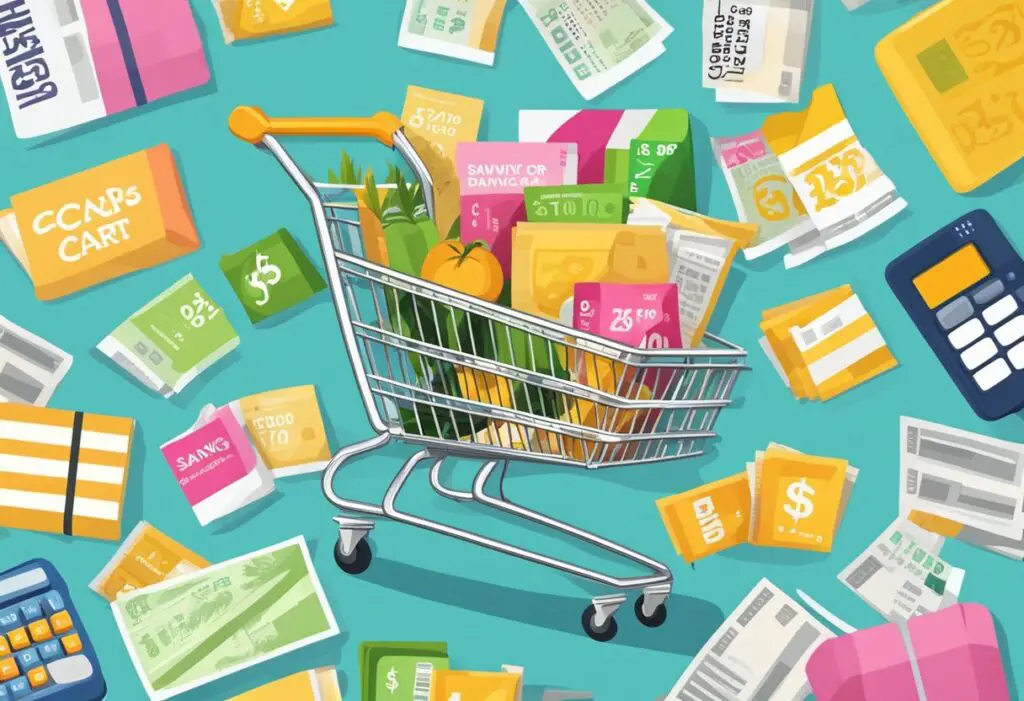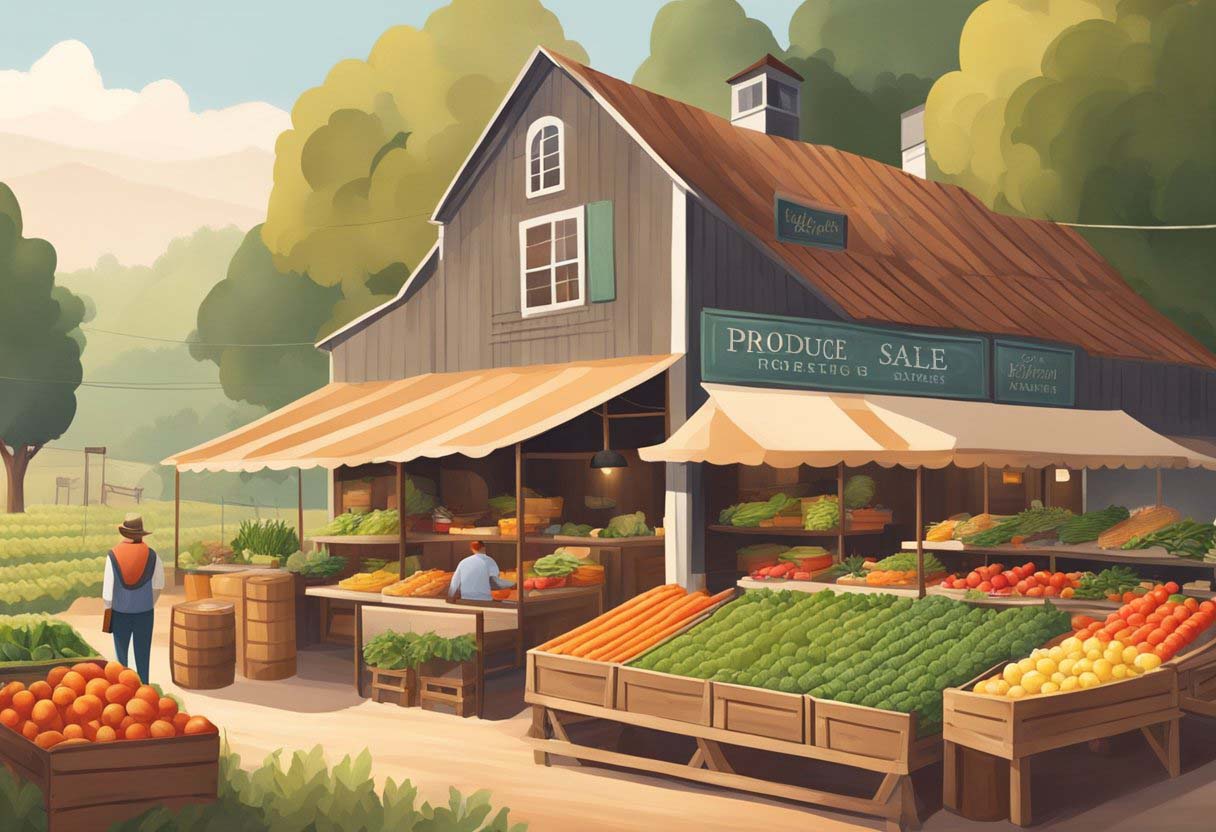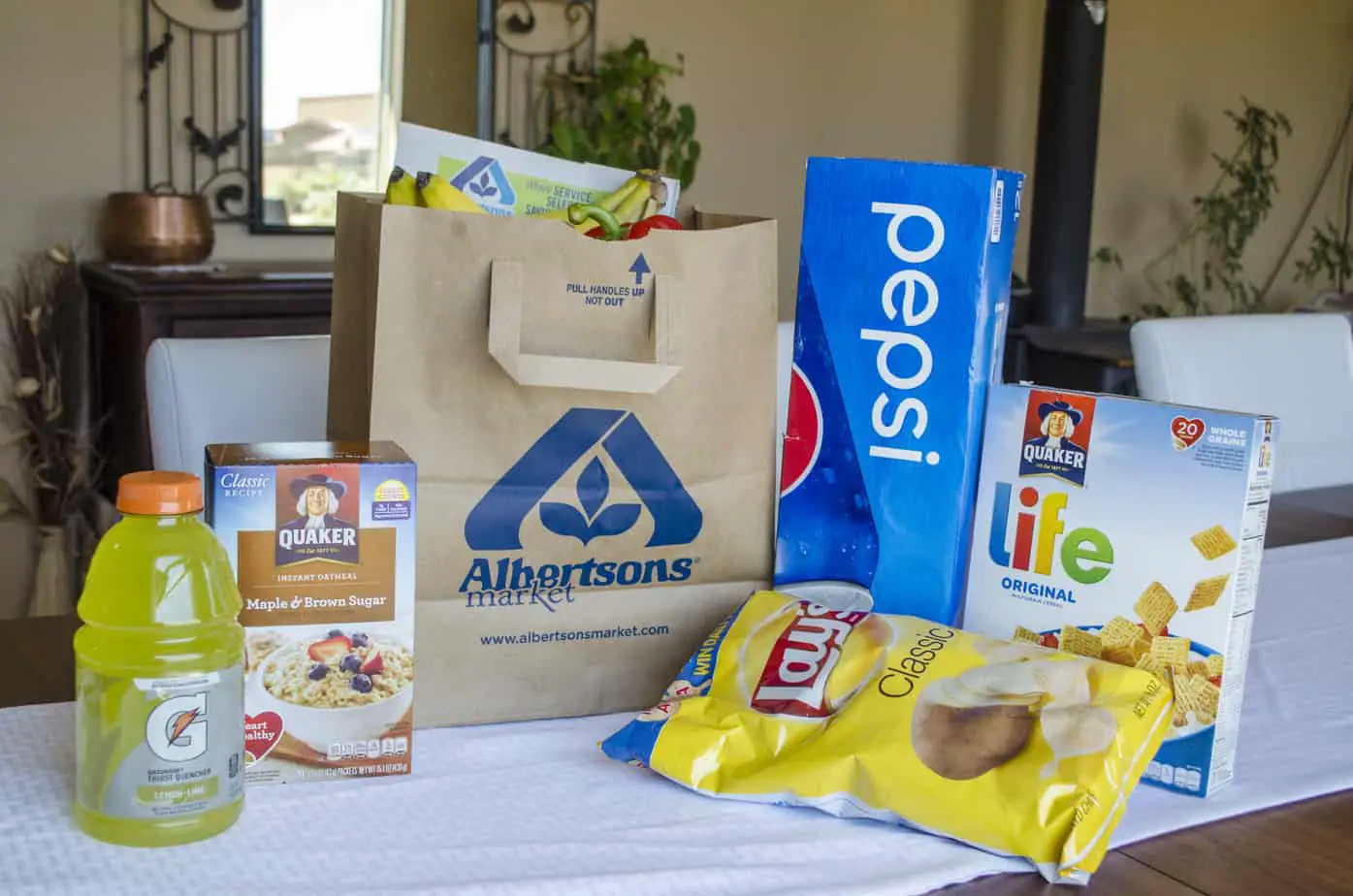Ultimate Guide to Online Couponing in 2024

As grocery prices continue to climb in 2024, the art of couponing may become a necessary skill for shoppers looking to stretch their hard-earned dollars further. Gone are the days when coupon clipping was a mere hobby; savvy Americans are learning the ins and outs of using paper and digital coupons when they go to the grocery store.
Can couponing in 2024 become a strategic component for a savvy shopper like yourself? If you haven’t jumped on the coupon bandwagon yet, read on to learn if this might be a good fit for you. Understanding the basics and discovering the right tools for your habits is key to making couponing work for you today.
Embracing technology is crucial for maximizing coupon savings; enabling you to track the deals you’re interested in and participate in “coupon stacking“, the ultimate goal of any couponer. (We’ll talk about that later in the article.)
Couponing isn’t just about cutting out paper clippings anymore—it’s about adapting to the current economy to support your financial goals and stretching those precious dollars!
Key Takeaways
- Couponing still reduces grocery expenses, give it a try!
- Practice makes perfect; discover the couponing habits that work best for you.
- Today’s technology can make coupon deal tracking and budget management easy.
Understanding Couponing Basics
Welcome to the thrilling world of couponing! With the right knowledge, you can unlock significant savings on your grocery bills. Let’s dive into the origins of this savvy shopping technique and explore the different types of coupons waiting for you.
History of Coupons and Couponing
Coupons have been your ticket to the savings party since their inception in the late 19th century. It all started with a small soda company, trying out a new marketing technique. (Which is really what coupons are, a marketing ploy.)
In 1887 Asa Candler (co-owner of Coca-Cola), introduced a simple paper ticket that could be exchanged for a free glass of soda to help advertise his product. People went nuts over it. Fast forward to today, and coupons have evolved into a strategic tool that savvy shoppers like you use to stretch their dollars at the grocery store and beyond.
Three Types of Coupons: Store vs. Manufacturer vs. Rebates
When you’re wielding coupons, it’s like having a superpower for your wallet, but you’ve got to know your gear:
- Store Coupons:
- The store itself issues these deals; every store does this differently, so research your favorite grocers.
- Usually found on store websites, within mobile apps, or weekly ads. Some coupons may only be available through the store app.
- Example: You open your mobile app for Albertsons Market and see a coupon for $3 off a dozen glazed doughnuts; this offer may or may not be in the store flyer.
- Manufacturer Coupons:
- These are offered directly by the makers of the products.
- They are distributed in print (you know, junk mail😉, also they can be found in newspaper inserts)
- Cannot be combined with other offers or used more than once. So, yeah, not the greatest savings here, but it’s something.
- They can be redeemed at any store that accepts coupons and carries the product.
- Websites like KlicktoSave.com and coupon.com are other places to find manufacturer coupons. ( However, there is a small fee to get these.)
- Rebate offers:
- Cash-back apps that will reward you for specific items you purchase. The cash can be used as credit for future purchases or deposited into your PayPal or bank account.
- Increase your savings when combining rebates with coupons.
- The most popular apps for rebate offers are Fetch, IBotta, Honey, Rakuten, and Shopkick. These rebate apps are great for stacking coupons! IBotta, Honey, and Rakuten will give rebates for online purchases as well.
- Checkout 51 and Swagbucks apps will not allow you to stack or use any coupons or store savings on your purchases. They will reject your receipt submission.
The holy grail of couponing is to be able to stack all three of these types of coupons or savings for one transaction (grocery haul). Understanding the difference between these deals can help you maximize your savings and conquer the aisles with your newfound coupon smarts!
Always check the fine print
It’s essential to check the coupon’s fine print for the ‘quantities’, ‘expiration dates’, and ‘size restrictions’. Never clip or tap to add a coupon without checking the fine print. Often coupons you find in flyers are not valid immediately, because their time window may open in the future.
“Transaction” and “purchase” mean two very different things in the couponing world. Understanding the difference is essential. Let me explain:
The “per purchase” phrase means one manufacturer coupon per item or, in other words, you can’t use two identical coupons for one item. It can be stated as, “one coupon per purchase”, “limit one per purchase”, or “limit one coupon per purchase of specified items”. Have two or more identical coupons? Purchase one item to go along with each of those coupons! Example: You have two identical coupons (two “$1 off a box of spaghetti”, and they say limit one per purchase). You can’t use both coupons on one box and get $2 off. BUT, you can grab two boxes of spaghetti and use one coupon for each box.
The “per transaction” phrase means you can only use one coupon for your entire grocery haul per visit to the register. Example: You cannot use 3 identical coupons on three separate jars of peanut butter. You can only use one coupon on one jar of peanut butter, and then pocket any other coupons you were planning on using, because you won’t be allowed!
Now, there are some tongue-in-cheek ways around the ridiculousness of the “per transaction’ fine print. Sometimes a cashier will allow you to separate out your groceries in line into multiple transactions, to get around this situation.
-OR-
I’ve heard of folks walking out the door after purchasing and turning right around to come back in. “Hey I’m back for another visit!” they said, and they proseed to use the rest of their coupons.
Strategic Coupon Collection
Strategic coupon collection is all about where and how to gather the treasure trove of savings for your grocery bill. By targeting the right sources and tools, you’ll be well on your way to maximizing those discounts.
Sourcing Coupons from Newspapers and Magazines
If you like shopping at Walmart, it’s a good idea to grab your Sunday newspaper—it’s a goldmine for paper coupons, which are the only type of coupons Walmart will accept. They don’t allow digital coupons at all, including screenshots of barcodes on your phone.
If you don’t receive regular junk mail coupon flyers, Klip2Save.com is essentially an online coupon flyer where you can pick and choose which coupons you’d like to be sent to you. However, they aren’t free- they cost a few cents to be sent to you. I’ve noticed that most of the manufacturer coupons listed there correspond to deals listed on the Walmart app for identical items. So compare savings between the two for the best deals if you shop at Walmart.
Digital Coupon Platforms and Apps
Step into the digital age with digital coupons; these are your allies in the battle against full price. Explore popular platforms like Ibotta where cashback opportunities abound. Get familiar with your favorite grocery store’s apps, as they often offer personalized deals. Here’s a nifty tip: link your store loyalty card to these apps for automatic savings at checkout. With a quick scan from your smartphone, you’re stacking discounts effortlessly.
Another very popular app is the KrazyCouponLady app, which is a great place to start learning how to coupon in the digital age. Krazy Coupon Lady began as a money-saving blog many years ago and now has a YouTube channel, an app, books, and several TV appearances. KCL continues to be a very popular resource for saving money on groceries and retail items in 2024!
Personally, I’ve found the free KCL app (Krazy Coupon Lady) to be the best place to start if you want to dip your toe into couponing. The search feature within the app will find you deals in all three categories of savings mentioned above; manufacture coupons, store coupons, and rebates. It will tell you how and where to get them. So convenient! You just have to download it and create an account.
Social Media groups
Lots of tips for finding great deals can come from social media. There are Facebook groups that specialize in sharing hot deals and some of them are huge, with hundreds of thousands of members who live to brag about their savings and how they achieved them. Simply open Facebook and search “couponing” to find the groups for you!
Reddit is another awesome place to discuss tips and tricks for couponing today. I would recommend starting with r/budgetfood, r/couponing, and r/frugal discussion boards.
Developing a Coupon-Savvy Mindset
When beginning to coupon, I recommend starting slow at first, with just one source like the flyer or app of the grocer you shop most, or download one coupon or rebate app. You may feel the savings are small at first; this is typical. You’re just learning how this stuff works so be patient with yourself! If you practice, you’ll start to see the patterns and feel confident enough to start checking and keeping track of multiple sources of savings.
Embarking on a couponing adventure can transform your shopping experiences and lead to significant savings. The key to mastering this skill lies in taking time to plan ahead and steer clear of typical pitfalls, like impulse buys.
Importance of Planning Ahead
Map Out Your Strategy: Start by dedicating time each week, or paycheck, to look for coupons and plan your shopping list accordingly. This doesn’t have to take a ton of time, try working it in while you’re waiting in lines or spending time in the bathroom (You know what I mean :0) Go through your grocery list one by one and find those coupons!
I take my grocery list (don’t forget to add household items in there as well, cleaning products, paper towels, etc.) and search to see if anything on my list has a coupon. Then, I will check for deals on things I know I will need in the future. Cooking from your pantry is a huge way to save on your grocery bill, but you’ve got to remember to keep that pantry stocked!
| Item on Sale | Coupon Value | Final Price After Coupon |
|---|---|---|
| Rice crispy cereal | $1 off | $5.50 |
| Spaghetti | $0.25 off | $1.50 |
| Pasta Sauce | $0.75 rebate | $1.25 |
Remember, planning also means anticipating future needs; stock up on non-perishables when they’re at the lowest price!
Avoiding Common Couponing Mistakes
- Resist Impulse Buys: Just because you have a coupon doesn’t mean you should use it. If an item isn’t on your list or doesn’t align with your meal plans, it’s likely an impulse purchase that can lead to overspending.
- Ordering groceries online saves time: I’m not tempted to impulse buy a bunch of stuff like I would be if I were in the store. Grocers that allow online ordering have some crafty ways of encouraging impulse buying over the web, but it’s not nearly as tempting as being there in person.
- Know the Policies: Be aware of store coupon policies to maximize savings. Some stores allow you to stack coupons, leading to deeper discounts on your purchases.
- Too many stores in one trip: People sometimes get bogged down with couponing, as they feel it is too time-consuming. One surefire way to get burned out is to drive all over town to tons of stores to run in and buy the one or two items you may have coupons for. Don’t do this to yourself! The money you’ll spend on gas will cut into those savings, maybe even erasing them. Limit yourself to one or two stores per grocery haul and save your sanity.
- Check prices of generics: I am not above using store brands/generic items. I always compare the savings I will get from a brand-name product with the price of the generic equivalent. If I’m not saving more with the coupon I won’t bother using it. (If you don’t like generic items, this advice may not be for you)
By forging a money-saving mindset, you’re setting yourself up for success. It’s not just about clipping coupons—it’s about making them a lever in your financial toolkit to rein in spending and enhance your savings on groceries.
Maximizing Savings Strategies
Unlocking major savings on your grocery bill is all about two powerful tactics: loyalty programs that reward your consistency, and the strategic use of coupons to multiply your discounts.
Leveraging Store Loyalty Programs
Join the club! Your local grocery store’s loyalty program is a goldmine for savings. By signing up and using your loyalty card every time you shop, you gain access to exclusive discounts and personalized deals just for members. Some programs even reward you with points that can be exchanged for more discounts or free items, making each shopping trip more rewarding.
I live in a small town and I’m limited to Walmart and Albertsons for most of my grocery shopping. I have used the Albertsons app for years, which has great rewards points that I’ve used many times to save money.
However, I was very excited to see Walmart’s edition of Walmart Cash- their version of allowing digital couponing. Instead of purchasing items at a discount, the discount amount is rebated which you can use on future purchases. If you’re a Walmart Shopper, check out the video below to learn more about this new program.
Be aware that many stores offering points or credit set an expiration date for those credits to be used. Familiarize yourself with the stores you shop so you know just what to expect and when those credits will run out!
The Art of Stacking Coupons
Double the deal by stacking coupons on top of loyalty program offers. This savvy move allows you to use manufacturer’s coupons in conjunction with store coupons and sales. Imagine buying your favorite cereal at a reduced sale price, slashing it further with a store coupon, then applying a manufacturer’s coupon on top— and getting a rebate on IBotta, the savings are exhilarating!
This is where couponing really begins to pay off. Stores like Target and Walgreens are at the top of the list when it comes to couponer’s favorite places to stack coupons.
Remember, before you head to the cash register, always check if you can stack digital and paper coupons for the same item. It’s like a savings bonanza in your wallet!
Stacking can take lots of practice, so give yourself a break if you feel you can’t do it like the pros right away. The folks you see on reality TV have had years to perfect what they do and lots of time to do it. At some point, I’ll do a deep dive into coupon stacking and let you know how much money I end up saving. For now, I’m happy with meal planning and getting creative with what I have in the pantry.
Effective Shopping Habits
Embrace the thrill of saving big on groceries! Mastering a few effective shopping habits can transform your grocery trips from mundane to money-saving adventures.
Creating a Strategic Shopping List
Craft Your Master Shopping List with laser focus! Check your pantry, write down what you need, and then refine your list by consulting coupons and weekly ads. This way, you’ll snatch up the best deals and sidestep those tempting impulse buys.
Sample Shopping List:
- Milk – Check for discounts or cash-back offers!
- Bread – Is there a buy-one-get-one deal?
- Eggs – Look for store specials.
Meal Planning to Minimize Waste
Turn your meal planning into a cost-saving quest! With a budget meal plan that aligns with sales and seasonal produce, you’ll buy exactly what you need. This technique not only cuts costs but significantly reduces food waste, keeping both your wallet and the planet green. For example:
This Week’s Meal Plan:
- Monday Dinner: Grilled chicken with seasonal veggies. (Cook chicken in bulk for future meals.)
- Tuesday Lunch: Leftover chicken wraps.
- Wednesday Dinner: Pasta using leftover veggies and chicken.
Plan, save, and savor every bite! Check out my budget meal plans– I’ve done all the planning for you.
Smart Shopping Techniques
Buying in bulk can save money if you purchase the right kind. Having a stocked pantry really brings peace of mind and makes meal planning easy when you have what you need for dinner already stocked at home!
Bulk Buying and When to Stock Up
Bulk buying can be your ticket to enjoying substantial savings on non-perishable items and everyday essentials. Focus on items with long shelf lives like rice, pasta, or canned goods, and capitalize on the lower per-unit cost. Be strategic with sales cycles and stock up on items like toiletries and cleaning products when prices hit rock bottom. Remember, it’s not a good deal if it goes to waste, so only buy what you’ll use before it expires.
Comparing Prices and Finding the Best Deals
The art of price comparison is a surefire way to trim your grocery bill. Keep an eye out for cheaper options in different stores or consider opting for generic products, as they typically offer the same quality at a lower price. Hunt down the best deals by subscribing to store newsletters, using price-tracking tools, and becoming familiar with the usual cost of your go-to items. Your vigilance will pay off as you start recognizing true bargains from regular prices masquerading as sales.
Advanced Couponing Tactics
You’re about to uncover advanced strategies that can slash your grocery bill significantly. These tactics require a keen eye and a strategic approach, but when executed well, they can lead to impressive savings even amid rising food prices and inflation.
Doubling and Coupon Fine Prints
Leverage the power of doubling coupons to boost your savings potential. Stores occasionally offer special days or promotions where they will double the value of your coupons, turning a $1 saving into a $2 windfall. But, as I mentioned earlier, beware of the fine print. Always check the terms and conditions since some coupons may have restrictions on doubling. Pay close attention to details such as the maximum double value and which days the offer applies.
- Max Double Value: Check if there’s a cap to how much the store will double.
- Double Days: Note down the specific days when doubling is available at your local store.
Tracking Prices and Sales Trends
Master the timing of your purchases by tracking sales cycles to know when to use your coupons. Grocery prices oscillate over time, and noticing these patterns can help you decide when it’s best to strike with your coupons. Sales trends can be seasonal or based on store inventory rotation, providing you with opportunities to pair your coupons with sale prices for deeper discounts.
- Sale Patterns: Take note of seasonal discounts; use a spreadsheet or app to track them.
- Best Time to Buy: Pair your coupons with the lowest sale prices for optimal savings.
Understanding the intricacies of doubling and fine-tuning your timing with sales trends will empower you to make the most of your couponing efforts, even with fluctuating food costs. Get ready for your next grocery trip armed with these advanced tactics and watch your savings grow!
Budgeting for Grocery Shopping
Crafting a grocery budget that works for you and finding strategies to reduce costs without downgrading the quality of your food will go a long way toward savings at the grocery store.
Setting and Sticking to a Grocery Budget
First, you’re going to want to determine how much you can spend on groceries each month. Begin by reviewing your finances and deciding on a fixed amount that feels comfortable within your overall budget. Here’s a quick way to track it:
- Review your last three months’ grocery bills to get an average.
- Subtract any non-essential items you can live without.
- Set a realistic amount slightly below that average to challenge yourself.
Once you have a number in mind, it’s time to stick to it. Use a budgeting app, spreadsheet, or even good old-fashioned pen and paper to track every grocery expense. Stay excited as you watch the savings add up!
Reducing Costs without Compromising Quality
Believe it or not, saving money on groceries doesn’t mean you have to skimp on quality. Start by buying whole foods—they’re not only more nourishing but often less expensive per serving when compared to their processed counterparts. Here’s how to make whole foods work for your budget:
- Buy in bulk: Grains, beans, nuts, and spices are cheaper in bulk and last a long time.
- Seasonal produce: Fresh produce that’s in season is both cost-effective and at peak flavor.
- Store Brands: High-quality store-brand whole foods can be much cheaper than name brands.
You’ll find that as you begin your couponing journey, processed, name-brand foods make up the bulk of coupons you see these days. If eating healthier options like produce is important to you, stock up on it when you do come across a coupon and freeze it (except leafy greens of course). But products like bell peppers, broccoli, and carrots freeze well. When I stock up on potatoes, I’ll do a bulk prep of twice-baked potatoes, french fries, and hashbrowns. Then I store all of them in my freezer, so I don’t have to worry about my potatoes going bad!
Using Technology to Enhance Savings
Leveraging technology when shopping can unlock sizeable savings for you. From curbside pickup perks to maximizing credit card rewards, embracing the digital age transforms the way you save on groceries.
Curbside Pickup and Online Shopping Benefits
With online shopping, you have the power to compare prices in real time (something I do all the time), ensuring that you’re getting the best deal. I love taking advantage of free curbside pickup to save time and money; stores often offer exclusive discounts for this service.
- Online-exclusive deals: Look out for special discounts that apply only to online orders.
- Digital coupons: Use retailer apps to clip and apply coupons automatically at checkout.
Credit Card Points and Cash Back Rewards
Your credit cards can be a goldmine for savings if you choose the right rewards program. Look for cards that offer cash back for grocery purchases, AND don’t have a crazy high annual fee, which can erase all your savings. Usually, the higher the percent cash back offered, the higher the annual fee so read the fine print.
The right cash-back credit card for you will reduce your bill or accumulate points for future savings. There’s a great Reddit thread about different cards out there. Some cards Monitor the consumer price index to understand market trends and make informed decisions about when to use your credit card benefits.
- Cash back bonuses: Select credit cards that offer a higher cash back percentage for grocery spending.
- Points on purchases: Accumulate points for every dollar spent and redeem them for gift cards, travel, or groceries.
By tapping into online convenience and credit card benefits, your grocery shopping experience will be both cost-effective and rewarding!
Future of Grocery Shopping
As you look ahead, it’s clear that the grocery shopping landscape is evolving rapidly. You’ll see direct impacts on your shopping habits, especially with regards to pandemics affecting behaviors and the integration of subscription and delivery services into your routine.
Impact of Pandemics on Shopping Behavior
Pandemics have transformed the way you shop for groceries. In an effort to minimize contact, you’ve likely turned to online grocery shopping platforms more frequently, making use of the convenience and safety they offer. Stores have adapted by enhancing their e-commerce systems, ensuring you can get your groceries with minimal risk. Contactless payments have become the norm, and sanitation measures for delivered groceries have been stepped up.
The Rise of Subscription and Delivery Services
You can expect to see an increase in options for meal kits, grocery subscriptions, and personalized delivery schedules. These services will save you time but also may not save you money; this all depends on what your current shopping budget is. If the excitement of discovering new meals planned out for you, delivered right to your doorstep sounds great, give one or two services a try The convenience of automated shopping lists and recurring deliveries are designed with your busy lifestyle in mind, ensuring you never run out of your essentials.
So, Is Coupon Clipping Worth It?
Now that I’ve given you this firehose of information, you may wonder, is couponing worth the time? Yes! By embracing a blend of coupons, sales cycles, bulk buying, and rebates, you’ll tap into a treasure trove of savings needed to cope with the inflation we’ve seen over the last few years.
Stay alert for those sales! Timing is everything. The KCL app I mentioned above is fantastic for this.
- Organize your coupons and match them to in-store promotions.
- A quick calculation before the register can ensure maximum savings, and make sure those coupon discounts DO come off.
- Loyalty programs are a no-brainer—sign up and save.
Get pumped—every dollar you save is a step toward your financial goals. So wield that grocery rewards card with pride, become a coupon connoisseur, and redefine savvy shopping. Your wallet will thank you!






